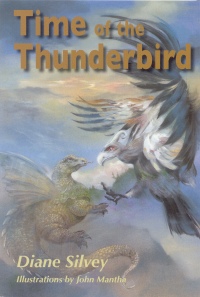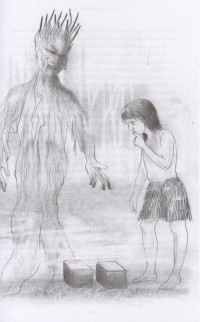| ________________
CM . . .
. Volume XV Number 10. . . .January 9, 2009 
 |
Time of the Thunderbird.
Diane Silvey. Illustrated by John Mantha.
Toronto, ON: Dundurn, 2008.
86 pp., pbk., $11.99.
ISBN 978-1-55002-792-1.
Subject Headings:
Coast Salish Indians-Juvenile fiction.
Quests (Expeditions)-Juvenile fiction.
Missing children-Juvenile fiction.
Grades 3-5 / Ages 7-10.
Review by Janet Grafton.
* /4
|
| |
|

excerpt:
The transformation was almost complete as the distinct shape of a wolf began to emerge. It stood tall and proud, enveloped in a shimmering, translucent bluish-white light that surged around its body. The wolf's steely gaze met and held Tala's while it relayed a telepathic message – a summons for help. Turning away abruptly, the wolf departed, taking quick strides down the beach. It stopped at the water's edge to look back over its shoulder for the twins. Satisfied they were following, it walked across the inlet without further ado.
The twins stood on the rocky shore, their mouths agape as they gazed in disbelief at the wolf's retreating figure. Their minds were hesitant to process the information their eyes had just relayed to their brains. Surely a wolf wasn't capable of walking on water, or was it?
"What now?" Kaya cried. "How can we follow it?"
"I don't know how, but I do know I'm honour-bound to go wherever my spirit brother leads," Tala said adamantly.
Time of the Thunderbird is the sequel to Diane Silvey's 1997 book, Spirit Quest, and it continues the adventures of twins Tala and Kaya.
All the children are missing in a small coastal village in British Columbia, having been stolen by an evil, power-hungry monster. Tala and Kaya must rescue these children from where they are being held in the Upper Reaches of the Shamanistic World. Along the way, the twins meet a series of mythical creatures that both help and hinder them.
Silvey's story reads as a parable for the history of residential schools in BC. A blend of myth, realism and the fantastic, Time of the Thunderbird highlights aspects of this history in a format palatable for young readers. But while the platform of fantasy can help approach a complicated topic, Silvey's attempt misses the mark.
 The setting for the story is rooted in the natural world, but frequent location shifts make it difficult to follow the narrative. Midway through the story, the village is named, but the lack of specific real details to ground the story weakens the potential power of fantasy. As well, the story begins in first person then switches abruptly to third, only to make another inexplicable switch later in the story. It could be that Silvey is experimenting with narrative form, but considering the age of readers for which this book is intended, these shifts read as a misstep. Likewise, her language is not always suitable for young readers: it veers between antiquated dialogue (the teenage twins say "Yonder" and "No indeed!" though no time frame is ever indicated, apart from subtext of the residential school history), overly sophisticated vocabulary (melee, stipulate, repertoire), and nonsense words (higgledy-piggledy, gibble-gabble). Phrases like "euphoric empowerment" are likewise clumsy and inappropriate for the age level of the intended readers. There is also a problem with wordiness: one page has nine adverbs, and the story in general is adjective heavy. The work is full of clichés such as "great gusto," "valiant efforts," "smashed to smithereens," "wracking sobs," and "plumb crazy." Also jarring is Silvey's frequent strays into didacticism: "And as everyone knows, it isn't right or natural for children to be separated from their families." The sentiment is valid but loses impact in being stated so blatantly, as do these passages: "In fact, he was downright obsessed with [riches], which was quite sad, since it blinded him to the important thing in life such as being part of a warm and loving community" and "they freely chose to practice conservation." It is the editor's job to tighten and clarify such writing, and a poor job has been done here.
The setting for the story is rooted in the natural world, but frequent location shifts make it difficult to follow the narrative. Midway through the story, the village is named, but the lack of specific real details to ground the story weakens the potential power of fantasy. As well, the story begins in first person then switches abruptly to third, only to make another inexplicable switch later in the story. It could be that Silvey is experimenting with narrative form, but considering the age of readers for which this book is intended, these shifts read as a misstep. Likewise, her language is not always suitable for young readers: it veers between antiquated dialogue (the teenage twins say "Yonder" and "No indeed!" though no time frame is ever indicated, apart from subtext of the residential school history), overly sophisticated vocabulary (melee, stipulate, repertoire), and nonsense words (higgledy-piggledy, gibble-gabble). Phrases like "euphoric empowerment" are likewise clumsy and inappropriate for the age level of the intended readers. There is also a problem with wordiness: one page has nine adverbs, and the story in general is adjective heavy. The work is full of clichés such as "great gusto," "valiant efforts," "smashed to smithereens," "wracking sobs," and "plumb crazy." Also jarring is Silvey's frequent strays into didacticism: "And as everyone knows, it isn't right or natural for children to be separated from their families." The sentiment is valid but loses impact in being stated so blatantly, as do these passages: "In fact, he was downright obsessed with [riches], which was quite sad, since it blinded him to the important thing in life such as being part of a warm and loving community" and "they freely chose to practice conservation." It is the editor's job to tighten and clarify such writing, and a poor job has been done here.
The last chapter is the strongest in the book, but it is also very disconnected from the rest of the story, with an abrupt transition from the fantastic to the real. However, the details of real village life are strong, which brings attention to the fact that Silvey is an award-winning nonfiction author; her strength as a writer can be seen in the glossary of Time of theThunderbird. Unfortunately, her publisher, editor and illustrator all do her a disservice with this work of fiction. John Mantha is an acclaimed illustrator, and his cover for this book showcases at least some of his talent, but the inside illustrations that accompany the text appear carelessly drawn and do not enhance or further the story. Likewise, consistently careless editing further damages the potential of Silvey's story: run-on sentences, inconsistent punctuation, and the use of "emboldened" twice in back-to-back paragraphs, which is also accompanied by the adverb "boldly." The plot jumps are nonsensical and push the capabilities of fantasy too far. The development of the story is awkward and episodic: the twins jolt from following a wolf to interacting with a dwarf to going on a treasure hunt, and the focus jumps from the evil stranger in the village to a beautiful woman in the Enchanted Valley to the Owl Man. But the most troubling aspect of the story is that the series of challenges the twins must face to reach the stolen children seem arbitrary, created only to fill narrative space.
The idea and history behind Silvey's story is compelling, and on occasion she embeds interesting cultural details into her work, such as the description of a traditional dessert called soopollalie. And while, at times, some characters and situations are reminiscent of fantasy texts like Carroll's Alice's Adventures in Wonderland and Ende's The Neverending Story, much stronger editorial work is needed to allow Silvey's strengths to outshine the weaknesses.
Not recommended.
Janet Grafton is a graduate student in the Master of Arts in Children's Literature program at the University of British Columbia in Vancouver, BC.

To comment
on this title or this review, send mail to cm@umanitoba.ca.
Copyright © the Manitoba Library Association. Reproduction for personal
use is permitted only if this copyright notice is maintained. Any
other reproduction is prohibited without permission.
NEXT REVIEW |
TABLE OF CONTENTS FOR THIS ISSUE
- January 9, 2009.
AUTHORS |
TITLES |
MEDIA REVIEWS |
PROFILES |
BACK ISSUES |
SEARCH |
CMARCHIVE |
HOME |

 The setting for the story is rooted in the natural world, but frequent location shifts make it difficult to follow the narrative. Midway through the story, the village is named, but the lack of specific real details to ground the story weakens the potential power of fantasy. As well, the story begins in first person then switches abruptly to third, only to make another inexplicable switch later in the story. It could be that Silvey is experimenting with narrative form, but considering the age of readers for which this book is intended, these shifts read as a misstep. Likewise, her language is not always suitable for young readers: it veers between antiquated dialogue (the teenage twins say "Yonder" and "No indeed!" though no time frame is ever indicated, apart from subtext of the residential school history), overly sophisticated vocabulary (melee, stipulate, repertoire), and nonsense words (higgledy-piggledy, gibble-gabble). Phrases like "euphoric empowerment" are likewise clumsy and inappropriate for the age level of the intended readers. There is also a problem with wordiness: one page has nine adverbs, and the story in general is adjective heavy. The work is full of clichés such as "great gusto," "valiant efforts," "smashed to smithereens," "wracking sobs," and "plumb crazy." Also jarring is Silvey's frequent strays into didacticism: "And as everyone knows, it isn't right or natural for children to be separated from their families." The sentiment is valid but loses impact in being stated so blatantly, as do these passages: "In fact, he was downright obsessed with [riches], which was quite sad, since it blinded him to the important thing in life such as being part of a warm and loving community" and "they freely chose to practice conservation." It is the editor's job to tighten and clarify such writing, and a poor job has been done here.
The setting for the story is rooted in the natural world, but frequent location shifts make it difficult to follow the narrative. Midway through the story, the village is named, but the lack of specific real details to ground the story weakens the potential power of fantasy. As well, the story begins in first person then switches abruptly to third, only to make another inexplicable switch later in the story. It could be that Silvey is experimenting with narrative form, but considering the age of readers for which this book is intended, these shifts read as a misstep. Likewise, her language is not always suitable for young readers: it veers between antiquated dialogue (the teenage twins say "Yonder" and "No indeed!" though no time frame is ever indicated, apart from subtext of the residential school history), overly sophisticated vocabulary (melee, stipulate, repertoire), and nonsense words (higgledy-piggledy, gibble-gabble). Phrases like "euphoric empowerment" are likewise clumsy and inappropriate for the age level of the intended readers. There is also a problem with wordiness: one page has nine adverbs, and the story in general is adjective heavy. The work is full of clichés such as "great gusto," "valiant efforts," "smashed to smithereens," "wracking sobs," and "plumb crazy." Also jarring is Silvey's frequent strays into didacticism: "And as everyone knows, it isn't right or natural for children to be separated from their families." The sentiment is valid but loses impact in being stated so blatantly, as do these passages: "In fact, he was downright obsessed with [riches], which was quite sad, since it blinded him to the important thing in life such as being part of a warm and loving community" and "they freely chose to practice conservation." It is the editor's job to tighten and clarify such writing, and a poor job has been done here.